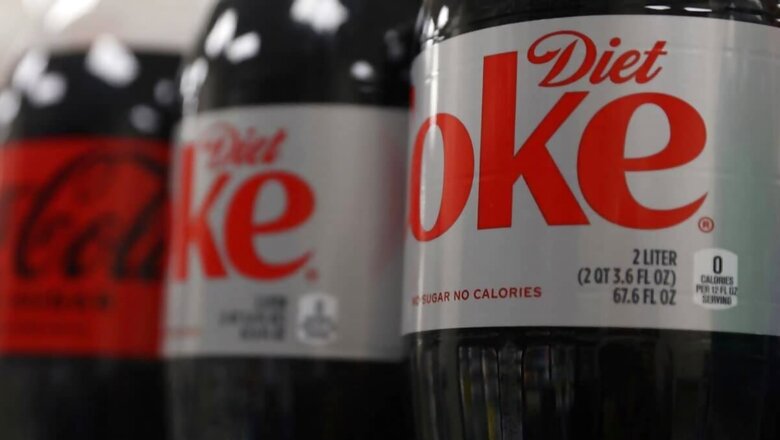
views
It’s the same artificial sweetener that has created a buzz across the globe after a news report said the World Health Organization (WHO) is likely to declare it as “possibly carcinogenic to humans”, which means that it may cause cancer in human beings.
Aspartame is used in more than 6,000 products, including artificially sweetened drinks, sugar-free gelatin products and hard candies among others. Some of these products carry warnings but not necessarily against Aspartame. For instance: Diet Coke’s label states that the product should not be consumed by children, pregnant women or lactating mothers. Similarly, Happydent Wave, Xylitol Sugarfree Mint prohibits children from consuming the product along with those who are ‘phenylketonurics’ – an inherited disorder that causes a build-up of phenylalanine, an amino acid, in the blood.
Story of Aspartame
In the late 1800s, scientists were on a quest to find an alternative to sugar after realising that its consumption leads to obesity, diabetes and heart disease. After sugar consumption became a public health issue, in 1878, scientists found saccharin – 300 times sweeter than sugar with zero calories. Then in the 1930s, cyclamate was found, which was around 50 times sweeter than sugar.
In 1960, Aspartame was found, which was 200 times sweeter and contained calories similar to sugar. However, it was sweeter, so it was used in a much lower quantity than sugar. In 1976, sucralose was found, which is 600 times sweeter and contains zero calories.
While at present, sucralose is used in the majority of food items apart from plant-based stevia, Aspartame was first approved by the US Food and Drug Administration (FDA) in 1981.
It was first sold under the brand name NutraSweet, for which the patent expired in 1992. It was approved for general use in the European Union in 1994.
Till 1995, Indian laws permitted the use of only saccharin as a sweetener and laid down that Aspartame is known to be unstable in glass bottles under tropical conditions. But later, it was approved and flooded the market as a “sugar-free” option.
WHO announcement coming on July 14
The WHO, in an email, told News18 that in its “Monographs Programme, International Agency Research Cancer (IARC), conducts hazard identification, which is the first fundamental step to understanding carcinogenicity”.
Dr Margaret Harris, spokesperson at the WHO, further said, “Hazard identification aims to identify the specific properties of the agent and its potential to cause harm, ie, the potential of an agent to cause cancer.”
“The classifications reflect the strength of the scientific evidence as to whether an agent can cause cancer in humans, but they do not reflect how high the risk of developing cancer is at a given exposure level,” Harris added.
Harris further said the evaluations were “independent but complementary” and conducted one after the other in June-July 2023. “Given the close collaboration between the IARC Monographs and the WHO/FAO JECFA Secretariat, we have planned to present the results of both evaluations at the same time. This will allow us to clearly communicate the different purposes of a hazard identification and a risk assessment and help put these results into context,” the expert said.
Harris added: “These complementary results will be announced jointly by IARC and JECFA on July 14, 2023, and are confidential until the summary of the evaluations of IARC Monographs Volume 134 is published online… by The Lancet Oncology, and simultaneous publication of the JECFA findings on the WHO website.”
Found to be carcinogenic in rats, mice two decades ago
A study by France released in March 2022, published in PLOS medicine, involving 1,02,865 French adults found that artificial sweeteners – especially Aspartame – were associated with increased cancer risk.
The study found that Aspartame intake was associated with increased breast and obesity-related cancer risks. It found an increased overall cancer risk for higher consumers compared to non-consumers. But this was not the first time when its links with cancer were established.
Published in 2005 in Environmental Health Perspective, an Italian study shows that Aspartame is a “multi-potential carcinogenic” compound whose carcinogenic effects are evident even at a daily dose of 20 mg/kg body weight – much less than the current acceptable daily intake for humans in Europe (40 mg/kg body weight) and in the US (50 mg/kg body weight). The study was conducted on Sprague-Dawley rats.
“The results of our study, therefore, call for an urgent reexamination of the present guidelines on the use and consumption of Aspartame (APM),” the study said in 2005 – almost two decades ago.
A follow-up study in 2007 found significant dose-related increases in malignant tumours in some of the rats. It also demonstrated that when life-span exposure to Aspartame begins during foetal life, its carcinogenic effects are increased.
“The results… confirm and reinforce the first experimental demonstration of [Aspartame’s] multipotential carcinogenicity at a dose level close to the acceptable daily intake for humans… when life-span exposure begins during fetal life, its carcinogenic effects are increased,” the researchers wrote in Environmental Health Perspectives.
In 2010, the results of a lifespan study again confirmed that “[Aspartame] is a carcinogenic agent in multiple sites in rodents and that this effect is induced in two species, rats (males and females) and mice (males),” the researchers reported in American Journal of Industrial Medicine.
Harvard researchers in 2012 found in the American Journal of Clinical Nutrition a positive association between Aspartame intake and increased risk of Non-Hodgkin’s lymphoma and multiple myeloma in men and leukaemia in men and women. The findings “preserve the possibility of a detrimental effect… on select cancers” but “do not permit the ruling out of chance as an explanation”, the researchers said.
US FDA calls it most studied food additive
On the contrary, the majority of studies proved that one needs to consume a lot of Aspartame to be at risk.
The US FDA – the world’s strictest health regulator – says Aspartame is one of the most studied food additives in the human food supply. “To determine the safety of Aspartame, the FDA has reviewed more than 100 studies designed to identify possible toxic effects, including studies that assess effects on the reproductive and nervous systems, carcinogenicity, and metabolism”, it said on its website.
FDA has set the ‘Acceptable Daily Intake’ limit for aspartame at 50 mg per kg of body weight per day, whereas European Union has recommended a slightly lower ‘Acceptable Daily Intake’ (ADI) of 40 mg per kg per day.
So, to consider aspartame as a potential carcinogenic, we also need to look at the amount an individual intake daily. If the amount is more than 40 to 50 miligram per kg per day, then it may prove carcinogenic to the human body. To give you an idea, a 60 kg adult would have to consume at least 12 cans of diet soft drinks every day to do that.
What needs to be seen now is the latest evidence that the WHO has gathered and the impact of the announcement on the food and beverage industry. For us, the rule remains the same – excess of everything is bad and moderation is the key.




















Comments
0 comment